The Colonial Model of Bible Translation in the East
In colonial history, we observe that wherever European colonizers sailed, their faith travelled with them. In their view, Christianity would bring positive change to the indigenous communities. To this end, missionary programs were established. The translation of the Bible into the vernacular was an integral part of this.
In Southeast Asia, the Dutch were the pioneers of Protestant Bible translation. The initial attempts were made in the Formosan language in Formosa (present-day Taiwan) and the Tamil language for the indigenous people of Northern Ceylon. Although the Dutch were behind these Bible translations, their attempts to produce a complete Tamil Bible in Ceylon and South India were soon taken over by the Danish mission. In the early eighteenth century the Danes sent out Bartholomew Ziegenbalg as a translator. However, he died at a young age and was replaced by Benjamin Schultze, who continued the translation of the New Testament into Tamil. In 1726, Schultze entered English service to work in British territories. This became a turning point in the history of Bible translation in the Indian subcontinent. English mission organizations became the key players in the field.
Urdu/Hindi ‘Authorized Version’
Urdu, Hindi and Hindustani are different names for the same language, written in two different scripts. This language is currently spoken by over 230 million people. Again, it were the Dutch colonizers who introduced Christianity in the Urdu language. The oldest Christian fragment in Urdu is the Lord’s Prayer, followed by the Ten Commandments and the Apostolic Creed, translated by Joan Josua Ketelaar (1659-1718) of the Dutch East Indies Company.
Urdu is written in Persian-Arabic script and has Arabic and Persian vocabulary due to the influence of Islam. Hindi uses the Devanagari script, influenced by Sanskrit and Hindu religion.
Ketelaar is also considered the first grammarian of the Urdu/Hindustani language. J. Ph. Vogel, “Joan Josua Ketelaar of Elbing, Author of the First Hindūstānī Grammar,” Bulletin of the School of Oriental and African Studies 8, no. 2–3 (January 1936): 817–22, doi.org/10.1017/S0041977X00141473.
A manuscript of his grammar containing the Urdu Lord’s Prayer is preserved in The Hague National Archives, Inv. no. 1.13.19.02, Coll. Sypestein, Supplement no. 2 (150 p.: iv (introduction)+125+21 (index).
Early in the eighteenth century, following the footsteps of Joan Josua Ketelaar, Benjamin Schultze began work on a translation of the New Testament into Urdu, Dakhini Urdu to be more precise, although Schultze also identified it as Hindustani. When Schultze entered English service (from 1726) he took this project with him. In addition to the New Testament, he also worked on several other books of the Bible, including Genesis. His translation of the New Testament was revised by his successor, William Hunter. William Hunter also published an Urdu translation of the New Testament in the Devanagari script in 1805. Next in line was Henry Martyn (1781-1812), who produced a complete translation of the Bible in Urdu. In 1814, the BFBS (British and Foreign Bible Society, founded 1804) published Martyn’s translation. This became the standard Bible translation. With some revisions, this is the translation still in use in Pakistan and the Urdu church in the diaspora. You could call Henry Martyn the man behind the Urdu ‘Authorized Version’, in use until today. His translation also became the basis for later Hindi translations used by the churches in India.
William Brown, The History of Propagation of Christianity Among the Heathen, vol. 1, Edinburgh 1823, 660-662.
Herbert Undy Weitbrecht, The Urdu New Testament: A History of Its Language and Its Versions, London 1900, 10.
Hunter’s New Testament in Devanagari script from 1805 is preserved in the archives of the BFBS. In the list of archives, this is the oldest Urdu New Testament, but in Devanagari script, not Persian.
This overview shows that the English organizations were playing a dominant role in translating the Bible in this part of the world. Their Bible was the King James Version (KJV). Unsurprisingly, therefore, the KJV was used as the model upon which the new translations were crafted. The style, approach and ‘format’ of the KJV were the model to be followed. Whether you look at Pakistan, India, Bangladesh, Iran, Afghanistan, or Sri Lanka, translations everywhere in South Asia followed this model. English dominance was reinforced by the major role the BFBS played in printing and making Bibles available.
European colonialism brought with it the belief that the indigenous population had to be converted and civilized. The Bible played an important role in this. Making the Bible available in the indigenous languages was seen as a “primary civilizing tool to save and improve the native." However, the missionaries brought with them a ‘European’ Bible, mostly the KJV. This constituted the obvious model for them. In doing so, they had little regard for the religious landscape of the Indian subcontinent: “protestant missionaries were ill-prepared for the number and variety of scriptures they had to face in United India, namely, Quran, Vedas, Puran, etc.”
Hephzibah Israel, Religious Transactions in Colonial South India: Language, Translation, and the Making of Protestant Identity, Basingstoke, Hampshire 2011, 77.
Israel, Religious Transactions, 34–36, 76, 106.
Israel, Religious Transactions, 42-46.
Colonial Model of Translation
The first Christian communities used the Urdu translation of the Bible (described above). This translation worked for them, because they had missionary priests to explain it to them. Slowly, this translation became ‘their’ Bible. However, the Christians formed only a very small part of society. The vast majority of the population of the subcontinent understood little of this new holy book. Instead of appreciation and acceptance, there was a sense of alienation and distance. The colonial features of the Urdu Bible were the reason for this alienation. These features were incompatible with the indigenous sacred writings of the Indian subcontinent or with translations of foreign sacred writings made by indigenous translators. The major problem was that the holy book of the Christians, the Bible, did not conform to the external features of holy scripture that people were used to. I will show this step by step below.
1. Where Is the Source Text?
Christianity has a long tradition of the Bible translation taking the place of ‘the text’. It is the translation itself that represents the source text and counts as a sacred text. However, this did not and does not match the expectation in many Eastern countries. Here, the expectation is that the source text remains visible and the translation is subservient to it. Behind this is the conviction that God speaks a holy language and not the language of the commoner. The translation itself is not the sacred text. Therefore, the translation should always be presented alongside the original text. Rabbi Saadiah Gaon (882-942), a prominent Jewish scholar who lived in Baghdad, present-day Iraq, was a pioneer in translating Hebrew writings into Arabic. In his translation of the Hebrew holy books into Judeo-Arabic, he offers both the translation and the original text. Since his time it is a practice in the east that a translation of holy scripture is published together with the source text. This has become a standard.

When the Quran was translated in United India, this model was followed. The first translation of the Quran in South Asia was the Persian translation by Shah Waliullah (1703-1762). His son Abdul Qadir (1750-1818) made the first-ever Urdu translation of the Quran, and both were printed alongside the source text.
Persian was the liturgical language for Muslims in United India. At the time of Waliullah, there was a debate whether, for the sake of reverence, the Qur’an could/should be translated into other languages or not. Waliullah took a bold step of translating the text, but presented his translation alongside the original text.

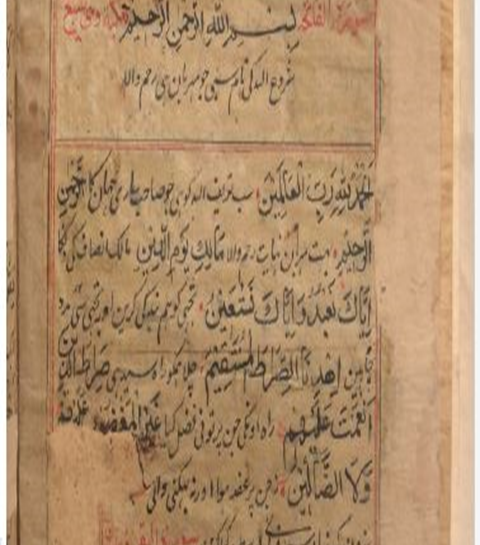
The translators of the Quran knew the importance of placing the source text with the translation. So did the translators of the Hindu scriptures. These sacred texts had been revealed in Sanskrit. Most of the population could not read the texts, but they could understand much of it when priests chanted them. When these texts were translated, the translators also included the source text in their translation. Maintaining the source text was also an essential element for Hindu scriptures.


Thus, the two majority religions of United India (98% of the total population), Islam and Hinduism, have as their standard that a translation of sacred scripture is always preceded by the source text itself. A translation without the source text is a feature of ‘ordinary’ literature, not of a sacred book.
Why did the colonial translators not include the source text? There were two reasons for this. First, for centuries in (Western) Christianity there had been the custom of considering the translation itself as the sacred text. Moreover, people were completely accustomed to the Bible as it appeared in its printed form: a European Bible. Second, Europeans brought with them their own idea of ‘sacred Scripture’: the Bible is meant to be understood. Emphasis is therefore on translation into the indigenous language. The goal of understanding the sacred text (in translation) is to some extent opposed to the custom of reciting the holy text (in its original language). The mantras of the Hindu scriptures and the Arabic chants of the Quran were and are recited in the sacred language. In doing so, the primary focus is not on understanding, but on experiencing. Europeans saw their use of the sacred scriptures, along the path of understanding, as superior.
Israel, Religious Transactions, 46.
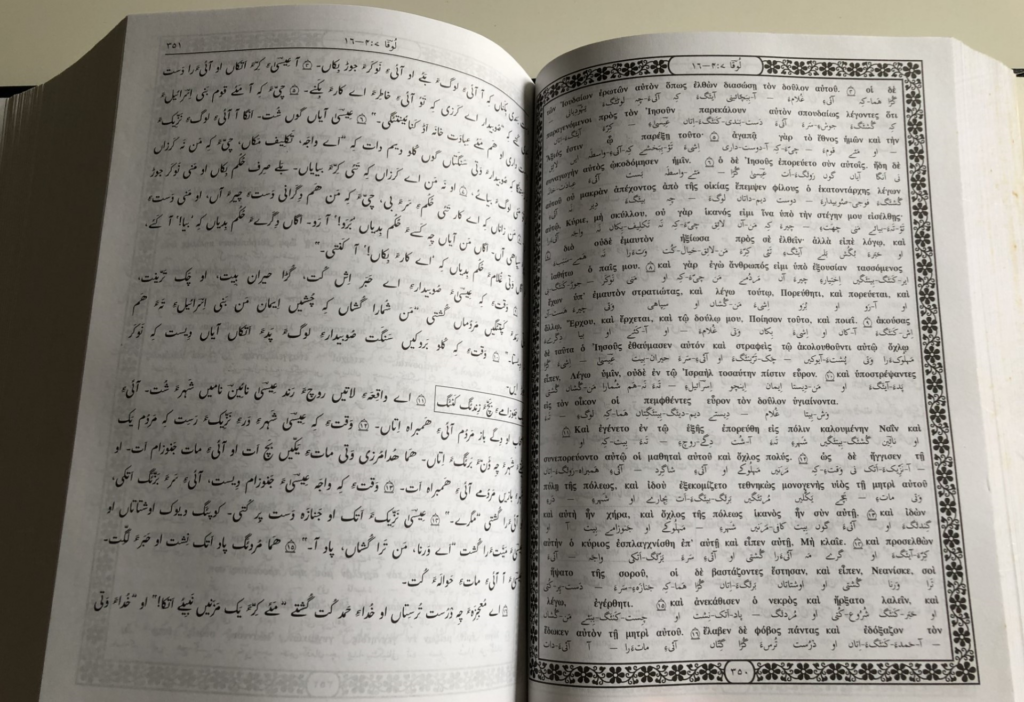
So the Bible, as elsewhere, was also presented in Southern Asia in the form of a vernacular translation without the source text. This had major consequences. Among Muslims and Hindus, this created the impression that the God of Christians does not speak a holy language. The holy book of the Christians evoked alienation and commanded little respect. This persist to this day. By exception, a very interesting recent development is the publication of the Balochi New Testament with the source text published by the Pakistani Bible Society. This may prove to be a first step in the direction of a new, postcolonial model of Bible translation.
2. Cover
What impression the Bible makes on the reader not only depends on its content. The appearance of the book is important as well. In this regards, the cover plays a major role. The covers of sacred writings in Asia are primarily green with beautiful calligraphy and works of art such as flowers, arches and domes. However, the European standard for the Bible in the nineteenth century was a black cover. The BFBS printed Bibles for the Indian subcontinent with a black cover. However, black is considered a color of mourning or misfortune in most Eastern cultures. Here, for comparison, are the covers of two Urdu Bibles and two Urdu Qurans.
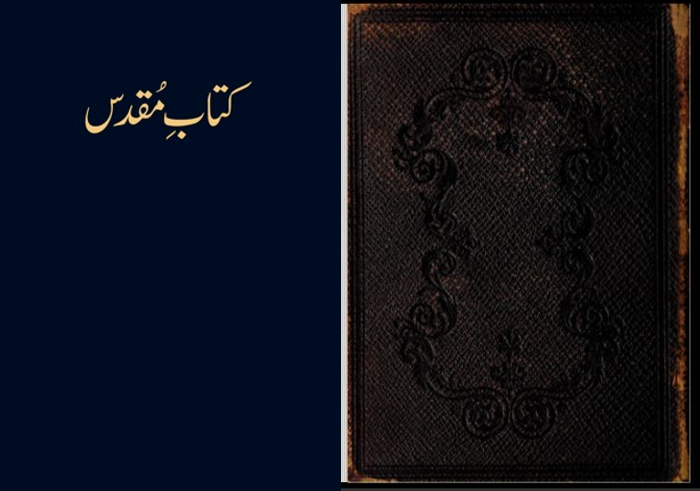
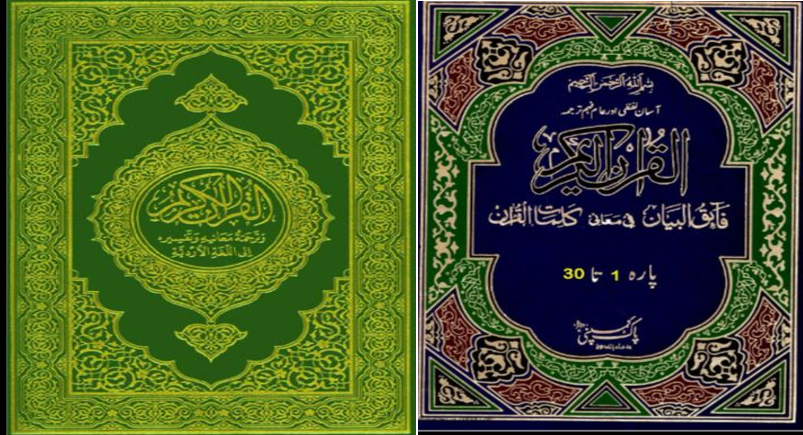
3. Title Page
The editions of sacred texts in Southern Asia usually have a title page with the names of the translators and publishers on it. However, this vital element is missing from the Urdu Bibles. One might think: perhaps this is because of the safety of the translators, especially in sensitive regions. But something else comes into play as well. The European standard of the nineteenth century was to leave the names of the translators out. In the Eastern context, the names of scholars responsible for a translation are actually important: it is through the authority and reputation of these scholars that a translation gains public respect and acceptance.
4. Margins
In Asia, it is common for translations of sacred scriptures to be printed with beautiful margins at the top, bottom, and sides of the page. These margins are filled with arches and domes, flowers and calligraphy. The Bibles (and other Christian writings) in the subcontinent lack this aesthetic element because – again – the European example is followed and not the indigenous one. Here are a few examples.
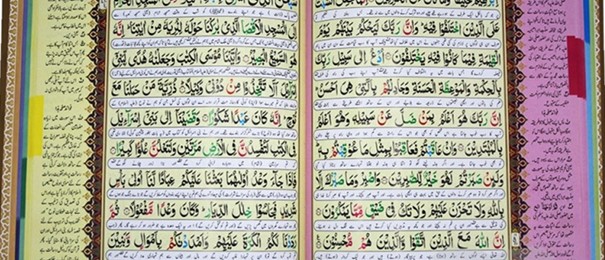
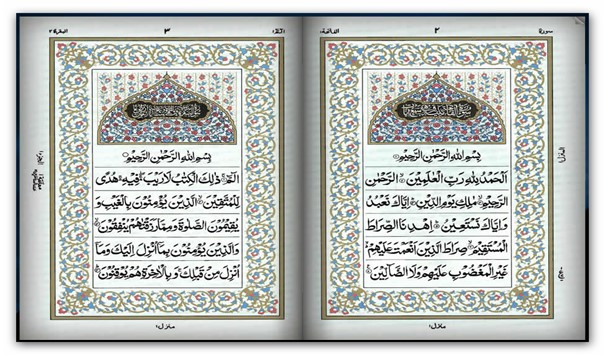
Informed by editions of the Quran and Hindu scriptures, the public expectation is that a holy book contains many aesthetic elements and looks beautiful: after all, it belongs to God! Unfortunately, the Bibles lack these elements. For comparison, here is a sample page of the Urdu Bible.

5. Text Formatting
The last point concerns text formatting. In most European Bibles, the text is printed in two columns. This is not a common layout for religious books in the East. The standard layout consists of horizontal lines and paragraphs. Interestingly, placing text in two vertical columns was not a standard from the beginning: for example, Benjamin Schultze’s first Urdu translation placed the text on horizontal lines. Here is Genesis 1.
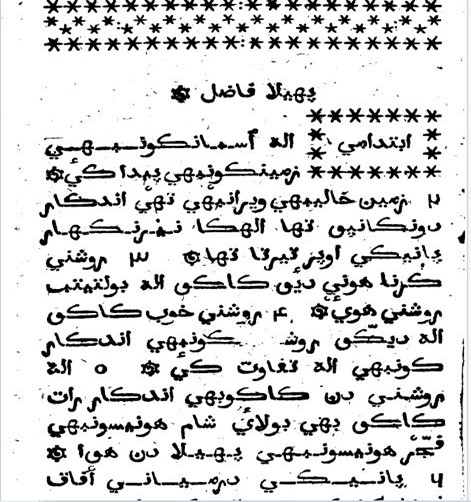
In 1883 we see for the first time that the text is placed in two vertical columns.

The two-column layout continued into the twentieth century and is still used today. But there are exceptions. The New Testament published in 1997 by the Bible Society of India in Bangalore again follows horizontal lines. Surprisingly, the cover is blue, not black.
Conclusion
Regardless of all the criticism of colonialism, as a Christian I am grateful for the missionary expeditions. These brought the Word of God to me and my people. That during the initial stages of Bible translation in the Indian subcontinent the Western model was followed – mainly the KJV – is understandable. The pioneers (mentioned above in the introduction) gave the best they could offer. But we are now also increasingly seeing the downside of Bible editions that do not meet cultural standards. For respect and appreciation from the predominantly Muslim and Hindu populations of the subcontinent, it is essential that the Bible presents itself as a holy book according to the accepted standard: as an aesthetically pleasing and richly decorated book, in the right colors, with authoritative names of translators, with the text on horizontal lines, and above all with the source text to the left of the translation. We are no longer a colony; we no longer need to stick to the European Bible as our model. Therefore, it is time for Bible translation and publishing to break free from colonial norms. It needs liberation so that God can speak to people’s hearts. Praise and honor to God.
From April-July 2023, Waseem Raza MA did a research internship at the Bible Society for the Netherlands and Flanders. In this internship, part of his master’s degree at the Vrije Universiteit, he elaborated his ideas on the colonial model of Bible translation. An earlier contribution of his on this topic can be read at PThU Bijbelblog
How to Cite This Article
Waseem Raza, 'The Colonial Model of Bible Translation in the East' in: Met Andere Woorden 42/online (9 November 2023), debijbel.nl.
Bibliography
- Brown, William, The History of Propagation of Christianity Among the Heathen, deel 1, Edinburgh 1823.
- Israel,Hephzibah, Religious Transactions in Colonial South India. Language, Translation, and the Making of Protestant Identity Basingstoke, Hampshire 2011.
- Nationaal Archief Den Haag, Inv. no. 1.13.19.02, Coll. Sypestein, Supplement no. 2 (150 p.: iv (introductie)+125+21 (index).
- Vogel,J. Ph., 'Joan Josua Ketelaar of Elbing, Author of the First Hindūstānī Grammar' in: Bulletin of the School of Oriental and African Studies 8/2-3 (january 1936), 817-822, doi.org/10.1017/S0041977X00141473
. - Weitbrecht, Herbert Undy, The Urdu New Testament. A History of Its Language and Its Versions Londen 1900.
Vakblad Met andere woorden
Met Andere woorden is hét tijdschrift dat je up-to-date houdt over het vertalen van de Bijbel. Ook biedt Met Andere Woorden inspirerende artikelen op het snijvlak van vertalen en Bijbeluitleg.
